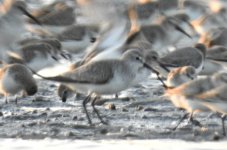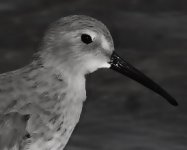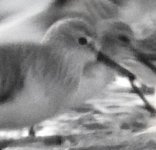-
Welcome to BirdForum, the internet's largest birding community with thousands of members from all over the world. The forums are dedicated to wild birds, birding, binoculars and equipment and all that goes with it.
Please register for an account to take part in the discussions in the forum, post your pictures in the gallery and more.
You are using an out of date browser. It may not display this or other websites correctly.
You should upgrade or use an alternative browser.
You should upgrade or use an alternative browser.
Red Knot ? Pakistan ? (1 Viewer)
- Thread starter Himalaya
- Start date
More options
Who Replied?Taken around Karachi recently - Red Knot is a rarity here.
Not a Red Knot - in this shot I cant see anything that suggests that it is not a Dunlin
RafaelMatias
Unknown member

Would you have any other photos at all of this bird?
RafaelMatias
Unknown member

Just the 1 sorry Rafael
Thank you. It's unfortunate, as I don't see this being a Dunlin as suggested above.
Deb Burhinus
Used to be well known! 😎

Dunlin for me - i can’t see anything to rule it out tbh (perhaps the slightly off’ bill shape is due to the angle/obscured by the leg of the background bird and movement on the camera and in the flock creating blur - but other than that, breast/pec band streaking and face pattern and general structure seem fine imo.
What other sp can be considered realistic? Broad-billed Sand? (but legs are too long/bill base too shallow/no split super) (I ruled out Curlew Sand on bill length/shape))
What other sp can be considered realistic? Broad-billed Sand? (but legs are too long/bill base too shallow/no split super) (I ruled out Curlew Sand on bill length/shape))
Last edited:
johnallcock
Well-known member
I agree with Rafael that it doesn't look like a Dunlin. The leg length, structure and plumage (particularly head pattern) look more like a Curlew Sandpiper to me. The main problem for that would be the bill, which seems too short and straight (but that is also a problem for Dunlin). It's a shame there aren't more photos.
Deb Burhinus
Used to be well known! 😎

I really don’t think Dunlin can be ruled out here with so much confidence!
Impression of leg length from a still image depends on posture at the time surely? - the bird is running/walking alert and in what looks like a fairly frenzied flock not the usual hunch back, head down pot belly posture associated with a Dunlin typically feeding on a cold winter mud flats!
‘long legs’ here
https://www.dreamstime.com/dunlin-r...ing-food-along-shoreline-taken-image159629262
and here!
https://www.gobirding.eu/Images/Waders/Calidris/Dunlin/Dunlin, Castro Marim, 27-Apr-06 (4) L.JPG
Plumage varies considerably on winter Dunlin from warmer tones to quite pale and grey as the OP bird and there is much definition lost so how reliable is what we see?
https://www.birdforum.net/opus/Dunlin
As for head pattern, again variable but to me still ok for Dunlin - see attached comparison of the OP bird and Dunlin - is there so much difference?
The bill is still problematic notwithstanding - The length of bill is short but I think still within range of a male Dunlin (ssp?) the downward curve again being quite variable depending on ssp/sex although, as mentioned earlier, the image is not very sharp and even a Dunlin with its bill very slightly open changes the shape - but definitely too short and the wrong shape for Curlew Sand imo.
I did consider Curlew Sand initially but immediately ruled it out on bill shape being enough alone (although it looks as if a couple of birds in the image could well be).
Edit - you know it might be helpful Himalaya, if you could post any other group shots in the same spot - it doesnt have to be the same individual but would give some context perhaps and also an idea of surrounding species for comparison of size etc - also can you re-upload a completely unedited version of this image please (ie ]uncropped etc)?
snapshots of birds can often give unexpected structural gizz as we know on this forum! I’d struggle to see a Dunlin in this shot in the link below if it was in silhouette only!!
https://www.flickr.com/photos/timmelling/42150216242
Impression of leg length from a still image depends on posture at the time surely? - the bird is running/walking alert and in what looks like a fairly frenzied flock not the usual hunch back, head down pot belly posture associated with a Dunlin typically feeding on a cold winter mud flats!
‘long legs’ here
https://www.dreamstime.com/dunlin-r...ing-food-along-shoreline-taken-image159629262
and here!
https://www.gobirding.eu/Images/Waders/Calidris/Dunlin/Dunlin, Castro Marim, 27-Apr-06 (4) L.JPG
Plumage varies considerably on winter Dunlin from warmer tones to quite pale and grey as the OP bird and there is much definition lost so how reliable is what we see?
https://www.birdforum.net/opus/Dunlin
As for head pattern, again variable but to me still ok for Dunlin - see attached comparison of the OP bird and Dunlin - is there so much difference?
The bill is still problematic notwithstanding - The length of bill is short but I think still within range of a male Dunlin (ssp?) the downward curve again being quite variable depending on ssp/sex although, as mentioned earlier, the image is not very sharp and even a Dunlin with its bill very slightly open changes the shape - but definitely too short and the wrong shape for Curlew Sand imo.
I did consider Curlew Sand initially but immediately ruled it out on bill shape being enough alone (although it looks as if a couple of birds in the image could well be).
Edit - you know it might be helpful Himalaya, if you could post any other group shots in the same spot - it doesnt have to be the same individual but would give some context perhaps and also an idea of surrounding species for comparison of size etc - also can you re-upload a completely unedited version of this image please (ie ]uncropped etc)?
snapshots of birds can often give unexpected structural gizz as we know on this forum! I’d struggle to see a Dunlin in this shot in the link below if it was in silhouette only!!
https://www.flickr.com/photos/timmelling/42150216242
Attachments
Last edited:
Jane Turner
Well-known member
I too am struggling to make it an obvious Dunlin [but there isn't a viable alternative] - its the fine, straight bill. It also looks very leggy, for a Dunlin, let alone a Knot. Do you have a less cropped photo, I'd like to get more of a feel as to how it compares to the birds around it.
It looks like a huge western sand, which it clearly isn't
It looks like a huge western sand, which it clearly isn't
Last edited:
kb57
Well-known member

The obvious thing about this image is it is much bigger than the smaller waders around it (although there are other similar sized, longer-billed species in the background).
As others have said, identifying the smaller species around it is key to getting a sense of scale - for it to be a dunlin, they would have to be stints, no?
As others have said, identifying the smaller species around it is key to getting a sense of scale - for it to be a dunlin, they would have to be stints, no?
CARERY
Well-known member
I was discussing this bird with a wader-maniac friend of mine and he suggested the possibility of a hybrid. We think Curlew Sandpiper should be involved (too long-legged for a Dunlin IMO). Is there any record of a Red Knot-X-Curlew Sand hybrid? Or is it just a odd-billed Curlew Sand? Puzzling bird indeed...
Last edited:
Nutcracker
Stop Brexit!
Could a wader survive getting the tip of its beak broken off? Is that a possibility? Have heard of waders with bivalve shellfish stuck on the end of the beak, that is a way it could happen, but would the bird survive the wound?
I find this a difficult to add much to what Deb Burhinus has said.
Straight culmen eliminates both Broad-billed and Curlew Sand. Other structure and plumage immediately rules out BBS and I dont think it looks like CS. Not long back from Namibia where I saw literally thousands of winter CS and it does not look close.
Therefore there seems to be two bits that are still being discussed, leg length and size.
Having done much birding in hot countries and lived in the middle east, including birding on the Gulf of Oman, I can say it is amazing how leggy birds can appear in hot climes. We are used to them fluffing feathers out for insulation, but when they are pulled in they suddenly get long in the leg. Nothing I see here is out of the norm for Dunlin.
Size is another matter. There a two questions that need to be answered. Is the size difference real or an artifice of the telephoto lens (this impact is well known due to the lack of depth of field). If so, how many races of Dunlin are present and if more than one, does this represent one of the larger eastern or northern subspecies?
Straight culmen eliminates both Broad-billed and Curlew Sand. Other structure and plumage immediately rules out BBS and I dont think it looks like CS. Not long back from Namibia where I saw literally thousands of winter CS and it does not look close.
Therefore there seems to be two bits that are still being discussed, leg length and size.
Having done much birding in hot countries and lived in the middle east, including birding on the Gulf of Oman, I can say it is amazing how leggy birds can appear in hot climes. We are used to them fluffing feathers out for insulation, but when they are pulled in they suddenly get long in the leg. Nothing I see here is out of the norm for Dunlin.
Size is another matter. There a two questions that need to be answered. Is the size difference real or an artifice of the telephoto lens (this impact is well known due to the lack of depth of field). If so, how many races of Dunlin are present and if more than one, does this represent one of the larger eastern or northern subspecies?
RafaelMatias
Unknown member

Not everything that is out there is identifiable to species. Pretending that we can identify anything is most likely the first step to make an avoidable mistake. For example: https://www.sibleyguides.com/2010/02/an-apparent-hybrid-sandpiper-in-thailand/
I believe that if we applied the arguments on this thread to the "Sibley bird" this would be dismissed as a Dunlin as well.
For me, the best option is just to admit we can't confidently know what the OP bird is, not based on this evidence at least.
I believe that if we applied the arguments on this thread to the "Sibley bird" this would be dismissed as a Dunlin as well.
For me, the best option is just to admit we can't confidently know what the OP bird is, not based on this evidence at least.
jmepler
It's just a flesh wound.

Very white unders, black legs, black bill (if opened ''slightly'') would make the bill look straight and even ended....consensus appears to rule out Dunlin and Curlew Sandpiper....then why not Sanderling?
Just a thought!
I had the same thought.
PYRTLE
Old Berkshire Boy

Very white unders, black legs, black bill (if opened ''slightly'') would make the bill look straight and even ended....consensus appears to rule out Dunlin and Curlew Sandpiper....then why not Sanderling?
Just a thought!
It appears to show a hind toe, though on reflection they could be strategically placed pebbles. I'm not sure it is contrasty enough though Ken for Sanderling.
Last edited:
Joern Lehmhus
Well-known member
That never occurred to me before - but looking at the "hind toes" they really appear like strategically placed pebbles to me now!
Sanderling seems a good bet then
Sanderling seems a good bet then
Deb Burhinus
Used to be well known! 😎

Pretending that we can identify anything is most likely the first step to make an avoidable mistake....
For me, the best option is just to admit we can't confidently know what the OP bird is, not based on this evidence at least.
Agreed
But personally, Rafael, I have nothing to prove - I am confident in my abilities as a birder without ‘pretending’ to identify anything! and humble enough to admit if there’s doubt. (And I do admit doubt as has most people on this thread)
Conversely, to your own ‘words of wisdom’, ‘the first step to make an avoidable mistake’ is by not ruling out more common species absolutely before jumping to hybrid theories (rare in the case of calidrids) . Part of that process when dealing with one (potentially artifact-laden), out of focus image, (especially in the absence of behaviour field notes or call descriptions ) is to at least first try and explain how the image may be giving ‘misleading impressions’ and give due attention to intraspecific variations among the more likely contenders.
Btw the links to the known wader hybrids you posted show clear and sharp images, including several of the birds from different angles with field observations of behaviour by the observers, so I am rather confused therefore, how you migrate the reasonings by other people on this thread that have been applied to one very less than clear image and apply them to a completely different set of images of a completely different set of waders and come up with your own conclusions as to what their outcome would be!
(Ken, the bird is showing obvious hind toes )
Without further images, conclusive ID is out of reach.
Users who are viewing this thread
Total: 2 (members: 0, guests: 2)






